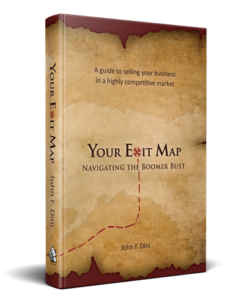“My timeframe? Talk to me in about five years.”
When business owners are asked about exit planning, that answer is almost ubiquitous. In fact, a much-quoted 2008 survey of owners by Price Waterhouse Coopers (now PwC – not clear why Mr. Waterhouse warranted lower case) found that 85% of private business owners said they expected to sell in five years.
Clearly, that didn’t happen, since it would have required some 1,500 businesses to be sold daily during that period. (The brokerage industry claims about 9,000 sales a year.)
 In fact, when the survey results were broken down, they discovered that 85% of 60 year old owners expected to sell in five years. Among 65 year olds, 85% expected to sell in five years. Among 70 year olds, you guessed it, 85% expected to sell in five years.
In fact, when the survey results were broken down, they discovered that 85% of 60 year old owners expected to sell in five years. Among 65 year olds, 85% expected to sell in five years. Among 70 year olds, you guessed it, 85% expected to sell in five years.
Clearly, “five years” is most owners’ shorthand for “I haven’t really thought about it.”
Realistic Timeframes
Exit planning and more importantly, implementing a plan, can easily take five years. That doesn’t include the time thinking about it, talking about it, or waiting for someone to call you up and make an offer.
If you are an owner-centric business (for example, a specialty craft where either you do the work or it is all done under your personal supervision,) you exit plan may be to close down. Even so, respect for your customers and employees suggests that discontinuing the business should take about a year.
Main Street businesses are those where another individual could step into your shoes and make a living. Such companies generally sell for less than $2 million. This is the market where business brokers excel. Expect the listing and sale process to take anywhere from nine months to two years. That is after you’ve done any needed clean-up of your records, contracts and procedure documentation.
If you plan to sell to employees without taking on all of the financing risk personally, allow at least three years to bring them into an equity position and document their ability to run the business without you. For most companies, five to eight years is a more realistic timeframe to accomplish this.
Selling to family members who are already capable of running the business is also time sensitive. A family transition can offer unique tax benefits, but the transfer mechanisms usually need at least five years for maximum benefit.
Selling to a family member who is not yet involved in the business is a much more lengthy proposition. I meet regularly with owners in their 60s who claim that a son or daughter in high school will be their successor. That timeframe requires the owner’s presence until well into his or her 70s or beyond.
Planning Isn’t Implementing
It makes little sense to embark on the biggest financial event of a lifetime without planning. However, plans can be made without rushing right into them.
Too many owners start to plan, only to find that the assumptions they’ve held for years aren’t true. Their estimate of value for the business is way off, or the key employee they assumed would take over has little interest in ownership.
Testing a plan for its practicality helps focus you in a specific direction. Does the business need to grow, improve profitability or take on new lines? Who are the buyers for a business of your size, or in your industry?
Investments in new hires and equipment are weighed for their long-term impact more than immediate need. Even if your target date is a decade away, you’ll start making strategic and tactical decisions based on your ultimate goal.
“Read” my latest book in 12 minutes!
 Your Exit Map, Navigating the Boomer Bust is now available on Amazon, Barnes & Noble and wherever books are sold. It was ranked the #1 new release in its category on Amazon, and is supplemented by free tools and educational materials at www.YourExitMap.com.
Your Exit Map, Navigating the Boomer Bust is now available on Amazon, Barnes & Noble and wherever books are sold. It was ranked the #1 new release in its category on Amazon, and is supplemented by free tools and educational materials at www.YourExitMap.com.
Now, we have a really cool 12 minute animated video from our friends at readitfor.me that summarizes the book, and helps you understand why it is so different from “how to” exit planning tomes. Take some time to check it out here. Thanks!

 That is a comforting thought to business owners who choose to see their one-person strategic planning team as a competitive advantage. Like the small furry mammals that survived as the dinosaurs died out, they are adaptable. The nimble small business can react to changes in the market faster, with less bureaucracy, and with greater attention to the customer’s needs.
That is a comforting thought to business owners who choose to see their one-person strategic planning team as a competitive advantage. Like the small furry mammals that survived as the dinosaurs died out, they are adaptable. The nimble small business can react to changes in the market faster, with less bureaucracy, and with greater attention to the customer’s needs.